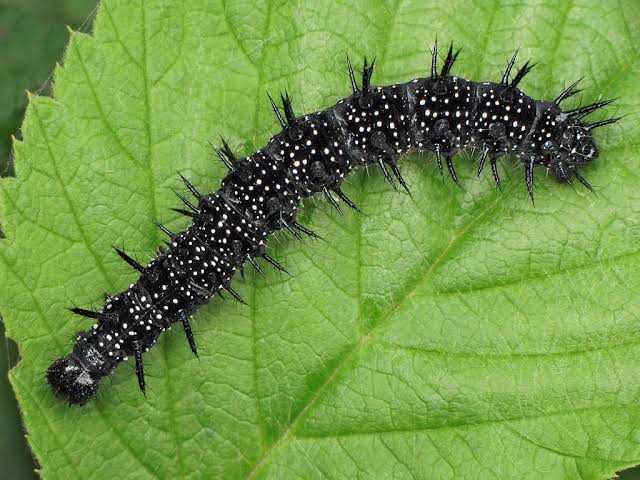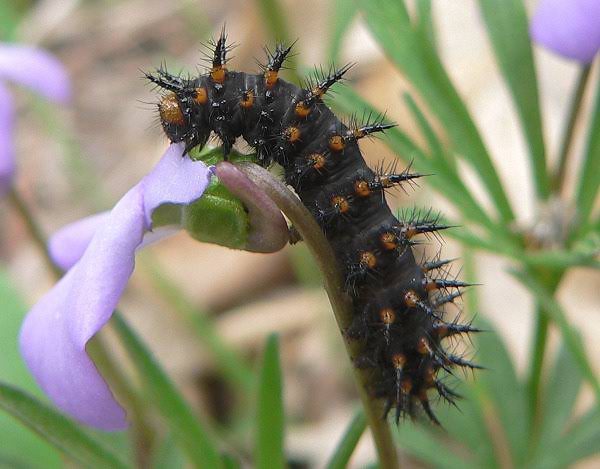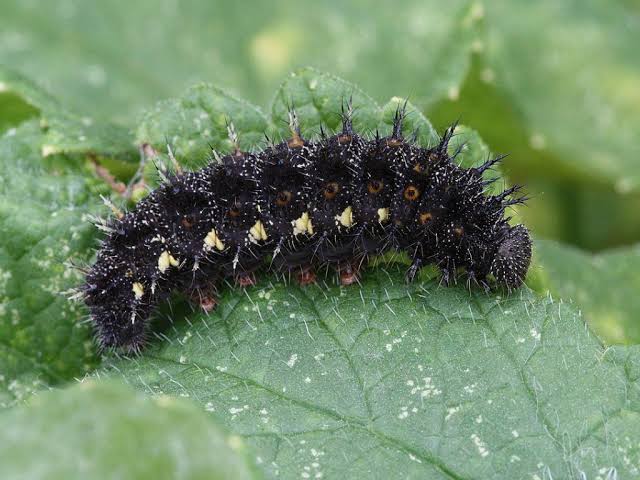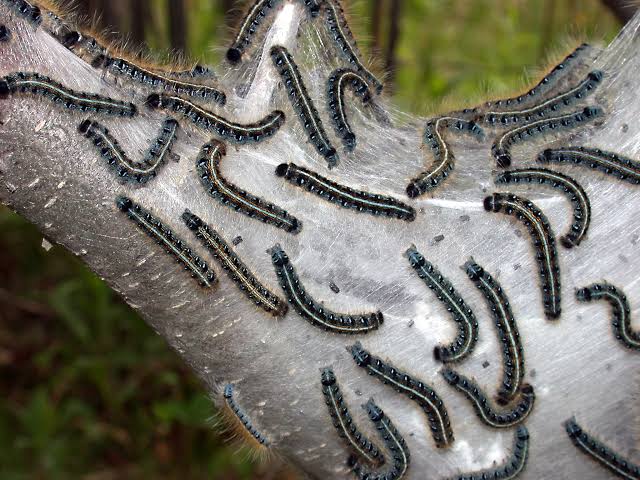A caterpillar is the larval stage of a moth or butterfly. It is the second part of their four-stage life cycle (egg, larva, pupa, adult). Caterpillars have long, worm-like bodies with six true legs. They can also have a variable number of stumpy false legs (called prolegs), which help them to move and cling to things.
The caterpillar is the growing stage in the insect’s life and it will moult several times to enable its body to expand.The stage between each moult is called an instar and most species undergo this process four to six times. Some caterpillars pupate within weeks of hatching and others overwinter, but, frustratingly, few are as easy to identify as that of the elephant hawk-moth.
Many of these caterpillars become distinct when they’re fully grown and looking for a place to either pupate or settle down for the winter, though some are easily spotted on their favourite food plants. Here are some of the black caterpillar species you might come across:
- Peacock Caterpillars (Aglais io)
- Giant Leopard Moth Caterpillar (Hypercompe scribonia)
- Mourning Cloak Caterpillar (Nymphalis antiopa)
- Pipevine Swallowtail Caterpillar (Battus philenor)
- Black Cutworm Caterpillar (Agrotis ipsilon)
- Garden Tiger Moth Caterpillar (Arctia caja)
- Azalea Caterpillar (Datana major)
- Scarce Dagger Moth Caterpillar (Acronicta auricoma)
- Walnut Caterpillar (Datana integerrima)
- Catalpa Sphinx Caterpillar (Ceratomia catalpae)
- Tersa Sphinx Caterpillar (Xylophanes tersa)
- Great Spangled Fritillary (Speyeria cybele)
- The Red Admiral Caterpillar (Vanessa atalanta)
- Eastern Tent Caterpillar (Malacosoma americanum)
Black Caterpillars
Peacock Caterpillar

Peacock caterpillars are shiny and jet black in color with white spots and black spikes along their back.The Caterpillars collaborate to spin a communal web on top of the leaf where they live and eat. Once the food source is depleted, they move to another part of the plant and spin another web. As they grow, the larvae begin to feed separately and go through five stages of growth called instars. They shed their skin several times, and grow up to 1.6 inches by the end of the fifth stage. They pupate alone and emerge as adults in July, at which point they store up fat to survive the oncoming winter.
Giant leopard moth caterpillars

The giant leopard moth caterpillars grow to approximately two inches long and are mostly black with tufts of stiff black hairs of equal length radiating around body. When curled, red intersegmental rings visible between the hairs. Spiracles orange or red. Early instar also has hairy tufts, but body colored dark brown and orange. They feed on a number of plants with broad leaves like violets, citrus, honeysuckles, magnolia, broadleaf plantains, lilac and dandelions.
Giant leopard moth caterpillars are primarily nocturnal, but are often seen crossing roads during the fall while seeking sites to spend the winter or found under leaves or in wood piles by people doing yard work during spring and fall. This caterpillar rolls up head to tail when disturbed.
Mourning Cloak Caterpillar

These spiny caterpillars are striking in appearance. Full grown Mourning Cloak Caterpillars are approximately 2.0 inches in length. The head is black with white hairs. The body is black covered with small white dots and numerous white hairs. There is a transverse row of stout branched spines (scoli) on each segment and most segments have a mid-dorsal reddish orange patch.
Caterpillars live in a communal web, and can defoliate entire branches. They feed on a variety of leaves, including willow, elm, poplar, and others. Older caterpillars wander about and may be found on plants that they do not eat.
Also Read: Yellow Caterpillars
Pipevine Swallowtail Caterpillars

Fully grown Pipevine swallowtail Caterpillars are around 5 cm in length and vary in color from dark brown to black. In areas of higher temperature such as Texas and Arizona, a red coloring dominates. They have bright orange spots on the ends of tubercles in rows along their body, and at either end of the body the tubercles are elongated into filaments. Full grown caterpillars have a glossy or velvet appearance due to many fine hairs.
Larvae spend almost all their time eating the leaves of their host plants. Once they completely remove edible matter from one plant they move to the next one. They eat in groups at first but as food sources deplete they become more solitary as they move on in search of fresh host plants.
Black Cutworm Caterpillars

Black cutworm caterpillars are gray to nearly black, with a light dorsal band and a ventral surface that is lighter in color. The ventral side is usually lighter, and this species does not have a dorsal band. The entire body is covered with granules and the dark brown head possesses many dark spots. The larvae have three pairs of true legs and five sets of fleshy prolegs (4 abdominal and one anal).
Young caterpillars feed on the plant and make holes in the leaves, older ones hide in the soil or in plant remains, and feed at night. They cut through stems just above soil level if the soil is moist; if the soil is dry the larvae chew into the plants below ground, and often the plants wilt and die.
Garden Tiger moth caterpillars

Tiger moth caterpillars are often quite hairy, which is why some are referred to as woollybears. This subfamily includes some of our most beloved caterpillars, like the banded woollybear, which is believed by some to be a predictor of winter weather. Other members of the group, like the fall webworm, are considered pests.
When fully grown Tiger moth caterpillars are about 60mm long with a black head, long white hairs set amongst a dense layer of shorter black and ginger hairs with a line of small white spiracular spots. As a group, tiger moth caterpillars feed on a wide range of grasses, garden crops, shrubs, and trees.
Also Read: Green Caterpillars
Azalea Caterpillar

Azalea caterpillar develop quickly from small green caterpillars to large, black and yellow-striped caterpillars with red heads and legs. The caterpillars feed in large groups, and can cause significant defoliation on individual branches. These caterpillars have a characteristically defensive behavior when disturbed – they raise their heads and hindquarters to form a “U” shape. However, they do not bite or sting with their hairy spinals. Their feeding rarely kills the azaleas but may slow their growth.
Dagger moth caterpillars

Dagger moth caterpillars are fuzzy with medium length yellow, yellow-green, or even white setae. They also have four, elegant, slender, black “pencils” of setae that extend out from the first and third abdominal segments. A fifth pencil of black bristles extends near the rear of the caterpillar. It is reputed that these pencils may break off and become embed into skin. Toxins supposedly inside the hairs are reputed to cause a stinging sensation that may develop into a rash. Caterpillars may grow as long as 2 inches and are often found on the soil near their host trees from July through late October.
Walnut Caterpillar

Walnut caterpillars are reddish brown to black with white markings and long white hairs. Large caterpillars are conspicuously fuzzy and may grow up to 2 inches (50 mm) long. They characteristically arch their heads and tails in a defensive posture when disturbed.
The Walnut caterpillars feed gregariously until they are ready to molt. Then they have a strange habit of crawling down onto the trunk in a group to molt. They leave behind a strange collection of molted skins. Fully grown caterpillars crawl or drop to the ground and crawl around looking for a place to dig in and pupate.
Catalpa Sphinx caterpillar

Catalpa Sphinx caterpillar is one of the “hornworm” species, having a prominent black spine on the back end of the body. The caterpillar has a shiny black head and grow up to 3 inches long. Although body coloration and markings change as caterpillars grow, lengthwise yellow or green and black stripes become more apparent in larger caterpillars. The caterpillars feed on the leaves of the northern catalpa and, more commonly, the southern catalpa, also known as catawba or Indian bean trees. These caterpillars are highly desired by fishermen as bait.
Tersa sphinx caterpillar

Tersa sphinx caterpillars are called “sphinxes” because they can rear up slightly and retract the head and three thoracic segments into the abdomen, a posture that somewhat resembles a sphinx. These caterpillars are snake mimics with a realistic pair of light-ringed eyespots on the first abdominal segment. Tersa sphinx caterpillars are variable in appearance. Some are pale green with pale eye spots whereas others may be dark with vivid eyespots. All specimens have a noticeable “horn” at the rear. These caterpillars grow to about 3 inches long. When mature, tersa sphinx caterpillars crawl to the soil surface and burrow into plant debris to molt into a pupa.
Great Spangled Fritillary

The caterpillars are black, with black spines that are yellowish orange at the base. The head is nearly black with some orange across the top. Caterpillars also have a bulb-shaped osmeteria-like gland located under the head. It emits a musky odor if the caterpillar is alarmed. First instar caterpillars look like tiny black fuzz balls. Immediately after hatching, they hide in the leaf litter near violets and go into diapause for the winter. Despite their impressive, branched spines, GSF caterpillars fall prey to insect, spider and bird predators. Black Swallowtail caterpillars eat a lot. They eat parsley, dill, carrot tops, Queen Anne’s Lace, Fennel and Turnips.
Also Read: Caterpillars With Stripes
Red admiral caterpillar

Red admiral caterpillars measure approximately 1 inch (2.5 cm) in length.They are highly variable in color. The head is black with short spines and hairs. The body varies from pale brown with a yellowish stripe on the sides to black with small white spots and a broken white stripe on the sides. Each segment has a transverse row of long, branching dark or pale spines (scoli) with reddish bases. These spines persist into the pupal phase.Young caterpillars may live together within a folded leaf nest. Older caterpillars are solitary and form their own enclosures.
The red admiral caterpillar eats plants in the Urticaceae, or nettle family. Adult red admirals usually eat rotting fruit, tree sap, and bird droppings, although they sometimes eat the nectar of flowers like daisies, asters, goldenrod, butterfly bush, and milkweed.
Eastern Tent Caterpillars

The Eastern tent Caterpillars are dark and marked with a white stripe down their backs. Broken lines of brown and yellow run along the the sides, punctuated by oval spots of blue. Generally, the caterpillars emerge in early spring. In their final instar, they reach over 2 inches long and sport visible hairs down the sides of their bodies.
These sociable caterpillars live together in silk nests, which they build in the crotches of cherry and apple trees. Eastern tent caterpillars may be confused with gypsy moths or even fall webworm.
Eastern tent caterpillars attack several species of broadleaf trees and shrubs, producing unsightly webs, or tents. When their populations become large, the caterpillars can defoliate trees, stunting their growth. They attack ornamental and fruit trees.
Further References
- Facts About Caterpillars: https://www.thoughtco.com/fascinating-facts-about-caterpillars-1968169
- Eastern Tent Caterpillar: https://entomology.ca.uky.edu/ef423
- Yellownecked Caterpillar: https://hortnews.extension.iastate.edu/yellownecked-caterpillar
- Types of caterpillars: https://leafyplace.com/types-of-caterpillars/
- British Caterpillars: https://www.woodlandtrust.org.uk/blog/2019/04/british-caterpillars/